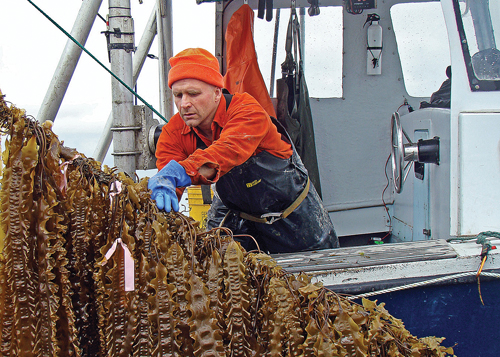Kelp, a slippery seaweed, could be major moneymaker

It’s a delicacy Asian cultures have enjoyed for centuries but is more commonly thought of as the slippery — and sometimes slimy — brown stuff that grows naturally in area waters and then washes up on beaches.
And one day, it could be a major moneymaker for the North Fork.
Though regional cash crops are typically cultivated on land, aquaculturists are pushing state and county lawmakers to permit the growing and selling of sugar kelp, or seaweed. They say the salty yet sweet leafy sea vegetable could benefit the economy, the environment, and even put baymen back to work at a time when making a living on the water is becoming increasingly difficult.
Researchers have suggested that farming kelp in Long Island Sound waters has the potential to produce annual sales of $47 million, according to County Executive Steve Bellone’s office. But in order for sugar kelp to be farmed in Peconic Bay and Sound waters — where many of the state’s aquaculture farms are located — state and county lawmakers need to make regulatory changes to allow it.
Currently, state law allows only for shellfish cultivation in these areas.
Cornell Cooperative Extension of Suffolk County is exploring the idea of growing the kelp industry locally and hopes to partner with researchers from the University of Connecticut on a study in Orient Harbor — if it can find the funds to do so.
Uncharted waters
“It’s exciting,” Southold aquaculturist Karen Rivara said of the industry’s potential while giving Mr. Bellone a tour of the Peconic Land Trust’s Shellfisher Preserve on Southold Bay last month. Ms. Rivara, who owns Aeros Cultured Oyster Company, is also president of the Long Island Farm Bureau. She is the organization’s first aquaculturist to hold that title. “I think it’s hard to find a reason not to do it.”
Area waters already ideal for growing shellfish are also perfect for kelp cultivation, she said, and would allow aquatic farmers another crop to harvest when the shellfish industry slows down, since kelp grows in the winter. The two can be grown in the same underwater space.
Ms. Rivara said the ultimate benefit of kelp is that it thrives on nitrogen, sucking up the very culprit wreaking havoc on the same waters, feeding harmful algal blooms and depriving waters of oxygen.
Growing shellfish and kelp side by side, she explained, would help protect her shellfish from being polluted by harmful algal blooms — one particular variety can cause paralytic shellfish poisoning in humans — and allow her to make a few bucks in the process.








